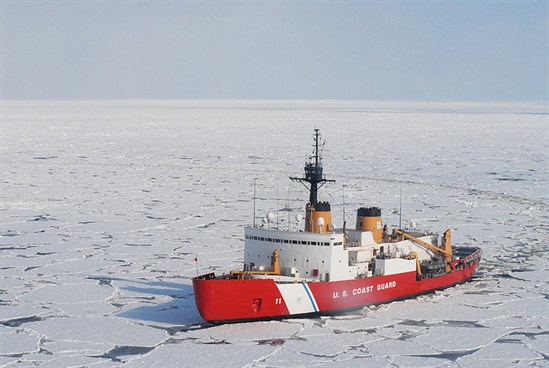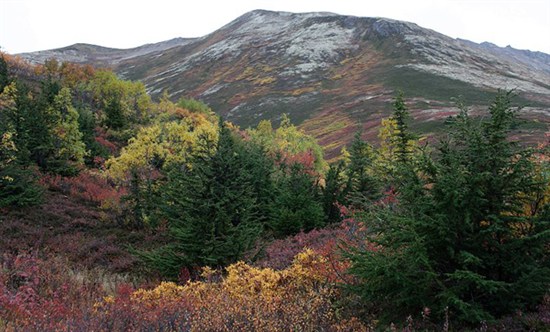Ros Donald
28.03.2014 | 3:45pmArctic sea ice is expected to have melted enough to open up shipping lanes for four months of the year by the middle of the century, a new UN climate report is expected to say. The new conditions could open up opportunities for some, but scientists tell us many are also likely to suffer as the region morphs into a busier, warmer place.
The new report from the Intergovernmental Panel on Climate Change (IPCC), Working Group 2 (WG2), tackles the impacts of climate change on the world, and how it may be possible to adapt to them. It’s expected to say the Arctic, which has warmed at about twice the global rate in the past three decades, will be a lightning rod for change.
The IPCC last year released the first of three bumper reports collecting and assessing five years’ worth of climate science data. Working Group 1 (WG1), which tackles the physical science of climate change, concluded that warming in the atmosphere and ocean is causing ice in the Arctic to shrink and thin. The loss of Arctic sea ice over the past three decades – at a rate of around 3.5 to 4.1 per cent – is unprecedented, it says.

A US Coast Guard icebreaker on a mission in the Arctic. Soon, the volume of shipping in the Arctic may increase as the region becomes more accessible. Credit: US Navy
Arctic impacts
Professor David Vaughan, Director of Science at the British Antarctic Survey was one of the lead UK authors on WG1. He tells Carbon Brief:
“There are undoubtedly human activities that will benefit from warmer temperatures and reduced sea ice.”
Vaughan was also an author on the IPCC’s previous report, which came out in 2007. He says even then, scientists predicted a mixed picture of costs and benefits as climate change affected the region. Of the 2007 report, he says:
“But in almost every case, even down to the level of specific communities, there are likely to be winners and losers almost living next door to one another. The issue is to understand that how the downside and upside is distributed across the Arctic from natural ecologies to human activities.”
The Arctic’s vast covering of sea ice has rendered it mostly inaccessible to commerce. But that looks set to change. Quoted in RTCC, a leaked draft of the report – due to be published in final form next Monday – says:
“The Northern Sea Route (NSR) is predicted to have up to 125 days per year suitable for navigation by 2050,” said the Intergovernmental Panel on Climate Change (IPCC), in a leaked report due to be published next Monday.”
Winners and losers
In an article today, the Times focuses on the positive consequences melting Arctic ice may have for some humans and natural systems, according to the draft WG2 report. It says:
“A leaked draft of a report by the Intergovernmental Panel on Climate Change lists benefits from the shrinking ice cap along with the well-known risks, such as the threat to polar bears and loss of Inuit hunting traditions.”
The benefits, according to the Times, include increased tourism. Already, the volume of tourist trips throughout Greenland, Norway, Alaska and Canada have increased rapidly. Killer whales and grey whales are expected to benefit from melting ice, “increasing opportunities for whale-watching trips”, the piece says.
Shorter journey times for commercial shipping thanks to access to Arctic waters may also cut emissions from ships, it adds. And oil and gas from the region is expected to contribute increasingly to the global economy, although the resources will be costly and difficult to access.
A complex picture
But these effects will have complex repercussions, as the Times also notes.
Even as some whales benefit from greater access to the seas, they, along with other marine mammals could find their breeding season disrupted as it coincides with the times when access to the Northwest Passage for shipping will be greatest.
The Times says the IPCC can only present “medium agreement” on forecasts that two-thirds of the world’s polar bears will be lost by 2050. However it notes that while “extinction of polar bears is unlikely”, there is “very high confidence” that sub-populations will disappear in some areas.
In its article, RTCC says added shipping and economic activity are also likely to increase the amount of soot pollution in the region, according to the leaked report. These deposits hamper the albedo effect – one of the earth’s natural cooling mechanisms, through which heat is reflected back from the Earth’s surface.

‘Greening’ in northern latitudes: Eagle River Valley near Anchorage, Alaska. Credit: Frank Kovalchek (Creative Commons)
Another area in which science is expected to have progressed since 2007 is the measurement of how the thawing of permanently frozen ground, or permafrost, is expected to affect the climate. When permafrost melts, it releases both methane and carbon dioxide into the atmosphere – though the effects of this release are hard to pin down. An added complication is that, especially in Russia, essential infrastructure such as buildings and roads are constructed on permafrost. Vaughan says:
“One thing I will be looking hard for in the report is how understanding on permafrost thawing has changed.”
It all adds up to a cascade of interrelated changes in the region. It’s unclear what the IPCC’s final report will say next week, but its previous work highlights other areas where changes will affect human and natural systems.
Vaughan points out that foresters in the region may benefit as warming temperatures make it ever greener. But natural ecological systems adapted to the ice will be pushed into smaller and smaller areas. Polar bears may not die out entirely, but they will be forced further and further north in search for their natural habitat, sea ice.
He says:
“We should remember that it’s not just climate change that will change the world we live in – it’s how climate change and human activities create multiple stresses on environments. It’s a very complicated picture and nowhere is the response to climate change more complicated than in the Arctic.”

